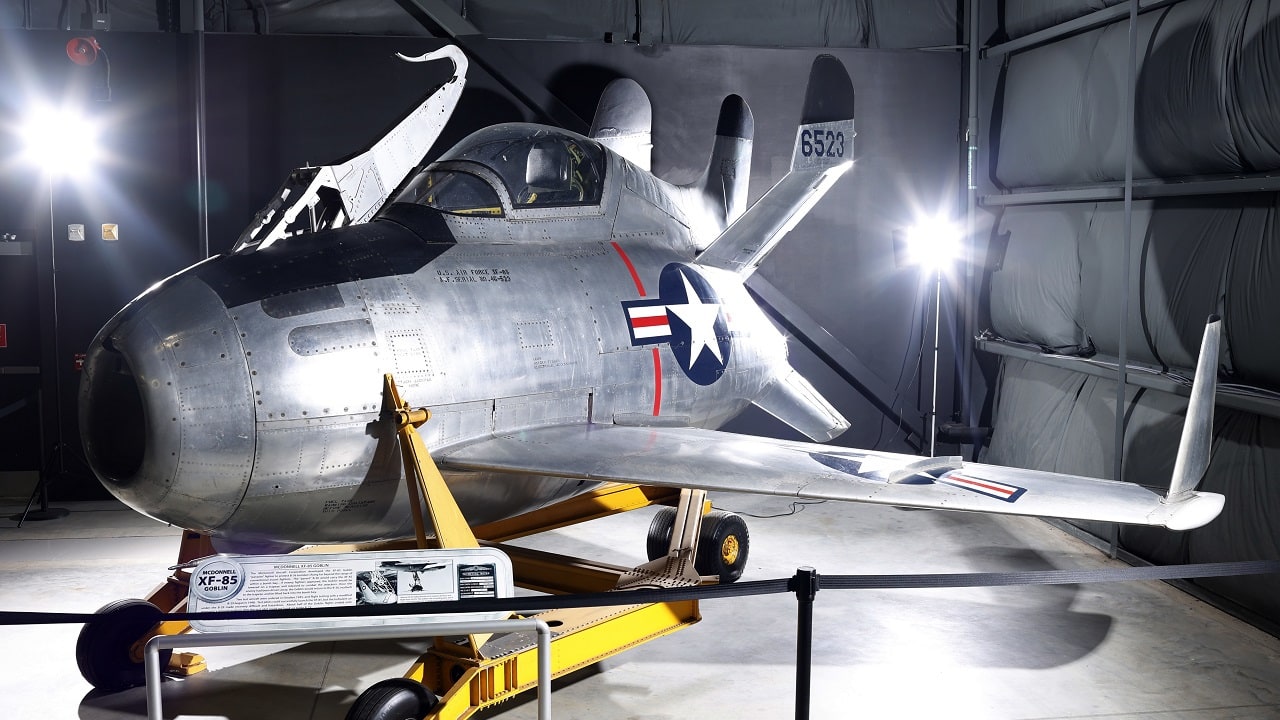The XF-85 Goblin was an idea that never made it into the Air Force’s mainstream thinking for many reasons: Its manufacturer called it the “Goblin”—and by looks alone, the egg-shaped jet certainly deserved the name. The McDonnell XF-85 jet resembled little more than a pressurized cockpit on top of a bulbous J34 turbojet engine, with small stubby swept-back wings that could fold inwards. Rounding out its ghastly appearance were an unusual three tail stabilizers, three shark-like belly-mounted fins, and a giant extendable hook rising from the open snout of its jet intake.
(Subscribe to 19FortyFive‘s New YouTube Channel here.)
To top off the Goblin’s disreputable looks, it lacked landing gear, and had to make do with a retractable steel skid for emergencies. That’s because the XF-85 was a “parasite fighter.” It was designed to be carried aloft by a huge nuclear bomber and air dropped to defend its ponderous mothership from attacking enemy fighters. Upon accomplishing its mission, the Goblin was supposed to use its protruding hook to snag a ride back to home base attached to its mothership.
The XF-85 was intended to protect gigantic B-35 fly-wing and B-36 Peacemaker strategic bombers designed to fly thousands of miles carrying nuclear weapons in their capacious bomb bays. These had fuselages large enough to fully enclose a Goblin in their bomb bays.
Though it may sound like a concept strait out of a Rescue Rangers cartoon, parasite fighters actually had a long but obscure history. The first were British biplanes that were tested hooking up to military airships during World War I. Then during the 1930s the Navy deployed F9C Sparrowhawk biplanes on board 239-meter-long helium-filled rigid airships Akron and Macon. The Sparrohawks also used hooks to “land” onto a trapeze extended from the airships. However, both scouting airships had crashed by 1935.
During World War II, the Soviet Union briefly mounted I-16 fighters onto a hulking TB-3 bombers for air strikes in 1941, and Japan deployed rocket-powered Okha (“Cherry Blossom”) kamikaze plans on G4M bombers.
The Air Force’s formally requested its own parasite fighters in January 1944 at time its long-range strategic bombers were experiencing heavy losses to German fighters in World War II. In the short term, the Air Force would develop effective long-range piston engine P-47 and P-51 fighters with drop-tanks to accompany the bombers all the way to target.
But the Air Force knew new jet fighters would soon enter service that would dramatically outperform piston-engine fighters—while also guzzling fuel at a much faster rate. Thus, the theory went that having a bomber lift parasite jet fighter into enemy airspace would overcome the range problem.
However, only the St. Louis-based McDonnell aircraft company responded to the Air Force’s request for proposals in March 1945. That October the Air Force ordered two XP-85 prototypes (later re-designated XF-85s) and additionally planned for parasite-carrying capability in its forthcoming B-36 bombers, some of which were planned to trade away their bombloads entirely to carry three XF-85s.
The Goblin actually exhibited decent handling characteristics and theoretically could attain respectable speeds of 650 miles per hour on its lone axial-flow turbojet. Four .50-caliber machine guns in the side fuselage were to constitute its relatively light armament.
As the B-35 never entered service and the B-36 was still being developed, in 1948 the Goblin was instead “nested” in the yellow-painted belly of a specially converted EB-29B bomber named “Monstro.” The little jet was attached via a retractable trapeze based on the type used on the Akron-class airships, with the lower half of the Goblin protruding from it.
As Goblin #46-523 was damaged in a crane accident during wind tunnel testing, #46-524 would fly all but one of the trial flights.
At first the XF-85 was carried aloft and retracted into launch position but not deployed. Finally on August 23, McDonnell test pilot Edwin Schoch launched the XF-85 from the extendible trapeze it was mounted on. The Pennsylvanian was an experienced Navy Helldiver pilot decorated for damaging a Japanese battleship during the Battle of Leyte Gulf.

